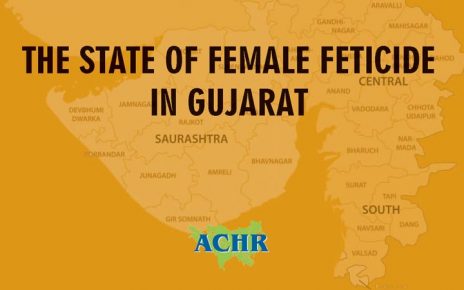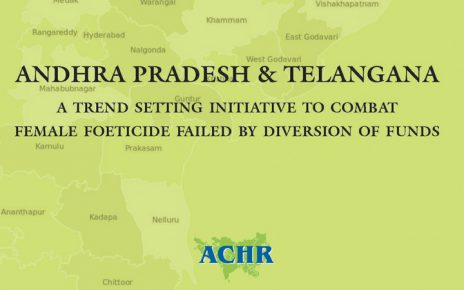As per census from 1981 to 2011, India’s only Muslim majority State Jammu and Kashmir (J&K) had recorded the highest decline in the Child Sex Ratio (CSR) by 102 points followed by tiny Dadra & Nagar Haveli (69 points), Haryana (68 points), Rajasthan (66 points), Himachal Pradesh (62 points) and Punjab (62 points), among others. There was no census in 1991 in J&K because of the insurgency. Census records nonetheless show that the CSR of J&K fell by 23 points from 964 in 1981 to 941 in 2001 and by 79 points from 941 in 2001 to 862 in 2011.
The technology enabling pre-conception and pre-natal sex determination and sex selective abortion can be described as the root cause for such drastic fall in the CSR in J&K. It is evident from the fact that the J&K had healthy CSR (959) in 1971 and further improved to 964 in 1981. The CSR sharply declined from 1981 but most drastically during 2001-2011 when access to technology for pre-conception and pre-natal sex determination became easily available.
Dowry vs Mahr: More sex selection in Muslims majority districts
Under dowry system practiced mainly by the Hindus, a bride/woman has to pay an amount of property or money mandatorily to her husband and family on her marriage. This makes daughter a burden on the family as women are tortured and murdered for not bringing enough dowry. The Government of India officially recognized dowry as one of the primary causes of son preference and sex selection leading to female foeticide and skewed CSR.
However, among the Muslim religious faith, mahr (dowry) has to be paid by the groom/man at the time of marriage which legally becomes bride’s property. Therefore, there have been claims of less female foeticide among the Muslims. Indeed, the national census data seems to suggest that: at national level as per 2011 census, Muslims had second highest CSR (943) after the Christians (958). The CSR of other religious groups as per 2011 census is 933 of the Buddhists), 913 of the Hindus, 889 of the Jains and 828 of the Sikhs.
However, this study shows that in the case of J&K, the Muslim dominated districts had witnessed unprecedented decline in the CSR with some districts witnessing decline up to 210 points (Pulwama) during 2001 to 2011. With the only exception of the Muslim-dominated Kargil district with the CSR decline of 2 points, all other districts under Kashmir division inhabited predominantly by the Muslims had registered the highest decline in the CSR during 2011 census. Out of 22 districts of the State, all the top 16 districts that witnessed sharpest decline in the CSR are predominantly inhabited by the Muslims (See Table 4).
Six districts i.e. Pulwama, Budgam, Kupwara, Ganderbal, Shopian and Kulgam having 94.5 to 98.5% Muslim populations were the worst affected. The CSR of Pulwama district with 95.4% Muslims declined by 210 points from 1046 in 2001 to 836 in 2011; the CSR of Budgam district with 97.6% Muslim population declined by 172 points from 1004 in 2001 to 832 in 2011; the CSR of Kupwara district with 94.5% Muslim population declined by 167 points from 1021 in 2001 to 854 in 2011; the CSR of Ganderbal district with 97.7% Muslim population declined by 151 points from 1014 in 2001 to 863 in 2011; the CSR of Shopian district with 98.5% Muslim population declined by 128 points from 1011 in 2001 to 883 in 2011; and the CSR of Kulgam district with 98.5% Muslim population of 98.5% declined by 121 points from 1003 in 2001 to 882 in 2011.
What is more alarming is the fact that as per 2001 census, these six districts had more females than males in the age group of 0-6 years with Pulwama (1046 females against 1000 males); Kupwara (1021 females against 1000 males); Ganderbal (1014 females against 1000 males); Shopian (1011 females against 1000 males); Budgam (1004 females against 1000 males); and Kulgam (1003 females against 1000 males).
The districts dominated by the non Muslims (Hindus, Sikhs and Buddhists) in J&K registered relatively “modest” decline in the CSR in comparison to the Muslim-dominated districts. Yet, it is pertinent to mention that the fall in the CSR among the non-Muslims in J&K is very high in comparison to fall of the CSR at national level which fell by 8 points from 927 during 2001 census to 919 during 2011 census8. In comparison, the CSR of Udhampur district with 88.15 Hindu population declined by 25 points from 912 in 2001 to 887 in 2011 while the CSR of Jammu district with 84.2% Hindu population declined by 24 points from 819 in 2001 to 795 in 2011; the CSR of Kathua district with 87.6% Hindu population declined by 11 points from 847 in 2001 to 836 in 2011; the CSR of Samba district with 86.3% Hindu population declined by 11 points from 798 in 2001 to 787 in 2011; and the CSR of Leh district with 66.4% Buddhist population declined by 11 points from 955 in 2001 to 944 in 2011.
A comparison in the fall of the CSR between the Muslims in one hand and the non-Muslims on the other in J&K (See Table 5) show that in 2001, 14 Muslim dominated districts had average CSR of 917 in 2011 and this plummeted to 815 in 2011 i.e. fall by 98 points. On the other hand, the CSR in four non-Muslim majority districts had an average CSR of 844 in 2001 and it fell to 826 in 2011 i.e. fall by 28 points. In 2001, the CSR (917) of the Muslim dominated districts was 73 points higher than the CSR (844) in non-Muslim dominated districts. However, by 2011, the CSR (815) of the Muslim dominated districts fell 11 points below the CSR (826) of non-Muslim dominated districts. This clearly shows that the Muslims of J&K had committed sex selection mainly during 2001 to 2011.
The unprecedented decline in the CSR as per 2011 census is unnatural and the only plausible reason is sex selection and female foeticide. This decline also shows that the practice of mahr (reverse dowry) amongst the Muslims of J&K had little impact to counter son preference and abuse of technology for sex selection.
Jammu & Kashmir: No measures to combat sex selection
The lack of any effective measure by the State Government of J&K to combat the use of technology for sex selection is the root cause of the drastic fall in the CSR from 2001 onwards.
No law of India can be extended to J&K by virtue of Article 370 of the Constitution of India unless the J&K Government extends it by an Act adopted by the State Legislature. The Government of J&K irrespective of whichever political party is in power has been reluctant to enact progressive laws.
Though the Pre-Natal Diagnostic Techniques Act, 1994 (PNDT Act) was promulgated in India in 1994, it was only on 23 April 2002 that the Government of J&K notified the J&K Preconception and Pre-natal Sex Selection/ Determination (Prohibition & Regulation) Act, 2002. It took another four years to notify the Jammu and Kashmir Preconception and Prenatal Sex Selection/ Determination (Prohibition & Regulation) Rules, 2006 on 7 December 2006. Effectively despite the rampant use of technology for sex selection since its invention in the 1980s till the enactment of the J&K PC&PNDT Rules in December 2006, there was no law to prohibit sex selection in the State. The result was the highest fall in the CSR in J&K among the States and Union Territories (UTs) during 2001 to 2011.
The implementation of the J&K PC&PNDT Act since the Rules were framed has been equally dismal. During 1 March 2011 to June 2012, the J&K Government sealed 147 clinics for conducting pre-natal sex determination tests. But as on date, only one conviction was secured in J&K. The scheme launched by J&K Government in June 2011 to give cash reward of Rs 25,000 which has since been increased to Rs 50,000 to anyone providing information with evidence on female foeticide has been a non-starter in the absence of any guidelines for implementation of the scheme.
Not a single disbursement has been made as on date under the Ladli Beti scheme launched by the J&K Government on pilot basis in six districts with low child sex ratio namely Jammu, Kathua, Samba, Anantnag, Budgam and Pulwama in September 2015 and Srinagar and Kishtwar districts in July 2016.17 Shri Bali Bhagat, Minister of Social Welfare Department of J&K stated before the J&K Legislative Council on 6 June 2016 that a total of 2,244 beneficiaries were identified under the Ladli Beti scheme but not a single disbursement was made to any beneficiary. Since July 2016, Kashmir division faced intermittent shut downs in protest against the killing of insurgent Burhan Wani of the Hijbul Mujahideen in an encounter on 8 July 2016. Obviously, implementation of the scheme has been the least priority and possibility since July 2016. In effect, the Ladli Beti scheme is yet to take off.
These six districts have also been implementing the Beti Bacho Beti Padao (BBBP), a Centrally sponsored Scheme focused on raising awareness on girl child. Out of the Rs 262.245 lakhs allocated under the BBBP, only Rs 182.237 lakhs were utilised while remaining Rs 80 lakhs remained unutilised as on June 2016.22 As the BBBP involves only awareness raising programmes, its impact is suspect.
In order to improve implementation of the Central PC&PNDT Act and address technological advancement on sex determination since 2002, the Government of India notified the PC&PNDT Amendment Rules of 2011 regarding seal and seizure of machine in unregistered centers; the PC&PNDT Amendment Rules of 2012 regarding regulation of portable machines etc; the PC&PNDT Amendment Rules of 2012 regarding restrictions on radiologists and sonologists from visiting more than two clinics within a district; the PC&PNDT Amendment Rules of 2014 regarding Form F on maintenance of records; the PC&PNDT Amendment Rules of 2014 regarding six months training for competency; and the PC&PNDT Amendment Rules of 2014 outlining Code of Conduct to be observed by Appropriate Authorities and Supervisory Bodies. However, no measure has been taken to incorporate these amendments to the PC&PNDT Rules under the laws of J&K.
As sex selection continues unabated and unchecked, J&K is all set to record once again the highest fall in the CSR during 2021 census and the CSR is expected to fall below 800 during the next census. It is pertinent to mention that during 2001 census only three districts had CSR below 900 but during 2011 census, 16 out of 22 districts had CSR below 900.
The lessons of Haryana, which had the lowest CSR (834) as per 2011 census among all the States and Union Territories (UTs), are instructive for J&K. Around 13.5% of Haryana’s young men between the age group of 25 and 29 were reportedly unmarried in 2010 primarily due to unavailability of brides. Unmarried men in Jind district with 871 females per 1,000 males as per 2011 census had even formed Jind Kunwara Union i.e. Jind Bachelors Union and demanded “brides” in lieu of their votes ahead of the Parliamentary elections of 2014.24 The absence of brides has been causing trafficking of girls/women from other States of India to be brides for men in Haryana.
The overall sex ratio at district level in J&K is far more serious than Haryana. The female sex ratio to male in Rajouri (860/1,000), Udhampur (870/1,000), Leh (690/1,000), Kupwara (835/1,000) and Kargil (810/1,000) districts of J&K is far worse than Jind district of Haryana (871/1,000) as per 2011 census (see Table 15). With polygamy being permitted in Islam, J&K is likely to face more challenges than Haryana arising out of female foeticide. However, given the imbroglio in J&K, political issues remain predominant and critical social issues such as missing girls which impact the entire future generation are ignored.




